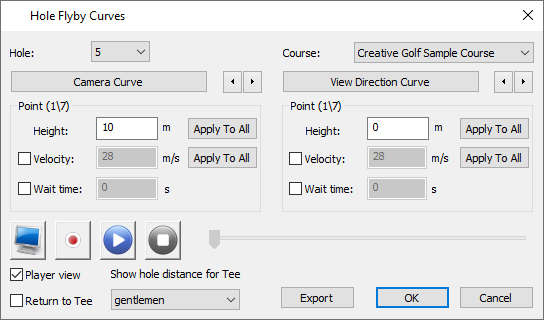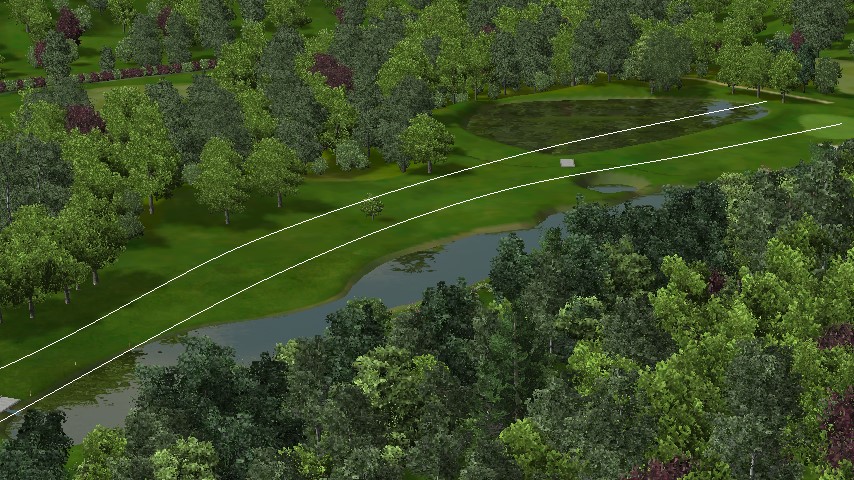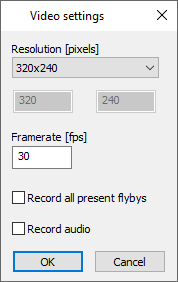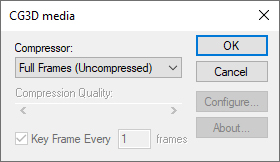To create a flight above a hole, use Hole Flyby Curves command.
You have following possibility to launch Hole Flyby Curves command:
- From Course drop down menu select Hole Flyby Curves
- Using icon from the toolbar


When the Hole Flyby Curves command is launched the Hole Flyby Curves dialog appears.

Hole – Click the arrow at the right side and select the appropriate hole number from the drop down list.
Note:
Each Flyby is connected with its hole properties which must be already defined in the map.
Camera Curve and View Direction Curve – Camera curve defines the camera movement itself during the flyby and the View Direction Curve defines the movement of view direction during the flyby. So, while the camera is moving along the camera curve, camera eye is watching the point which is moving along the view direction curve. The default speed is the same for both. If the view direction curve is shorter than the camera curve, camera eye is watching the end of the view direction curve for the rest of movement. To finish creating the curve choose Finish from right mouse click context menu.
Note:
It is recommended to use top view while creating the curve to easily gain the desired shape of the boundary curve and point positions.


Note:
To see curves in Side View, it is necessary to switch on the “Curves in Side View” check box in Visibility Filter dialog accessible via icon from the toolbar ![]() .
.
Height, Velocity and Wait time – Use them to define the properties of the grip points of curve.
Use arrow buttons < > to select next or previous grip point to change its properties.
The Height is edited as relative height above the terrain. The predefined value for the height of camera curve is 18m/yd. It means the camera flies 18m above the terrain. The predefined value for the view direction curve is 0. It means camera eye is watching the terrain along the view direction curve. After the flyby curve it is finished and saved, the height is saved as absolute height. So, the further modeling of terrain (creating of additional hills or holes) doesn’t affect the flyby curves.
Hint:
Hover cursor over the camera or view direction curve so, that it gets highlighted. From the right mouse click context menu choose Edit Flyby Curve to change again their height.
The Velocity allows to change the predefined speed of camera or speed of the point which is watched by the camera.
If the camera or watched point should stop for some time use the Wait time edit box.
Editing of Velocity and Watch time is not usual therefore use the check box in front of the edit box to edit the value.
Use button Apply to All to assign current Height, Velocity and Wait time values to all curve points.
Play and Stop – Use these buttons to review the created flyby in editor environment ![]()
Hint:
While playing, you can drag slider to move back or forward in the flyby timeline.
Record – Use this button to save the flyby as a video file ![]()
Resolution [pixels]: From the drop down list select the appropriate video size in pixels.
Framerate [fps]: Set the video framerate.
Record all present flybys: Click the checkbox if you want to record all available flybys.
Record audio: Click the checkbox if you want to record audio

Note:
Currently is no sound recorded in the avi file. Another opportunity is to use some external recording program for example Fraps which records concurrently and including the sound but it requires a powerful hardware configuration (CPU and GPU).
In the populated Save As dialog specify file name and location where the video file should be stored. Click Save button to close the dialog.
Compressor: From drop down list select the appropriate codec.
If available, set also the desired Compression Quality or click Configure button to see and change the codec properties.

Note:
This dialog is standard Windows dialog which offers all on the computer installed codecs. Not all of them are working correctly. Selecting some of them can cause the crash of program. Try to play with it a bit in advance to choose the working codec and to define the desired quality (flow).
Click OK button to confirm settings and start the recording.
Note:
While the flyby is recording, you can watch slider movement and a progress value in % at the bottom of Hole Flyby dialog. The recording is sometimes slowly – frame after the frame is generated and saved to the video file. But the advantage of this is that even on the slower machine is possible to generate the fluent video.
After the recording is finished, click Ok or Cancel to close the Hole Flyby dialog.
Full screen – Use this button to play the flyby in full screen mode ![]()
Note:
In a dual displays configuration the full screen mode uses the display which has been set as a primary.
Hint:
It is also possible to delete a flyby. Activate the Top View window and hover cursor over the camera or view direction curve so, that it gets highlighted. From the right mouse click context menu choose Delete Object(s) and click the OK button.
